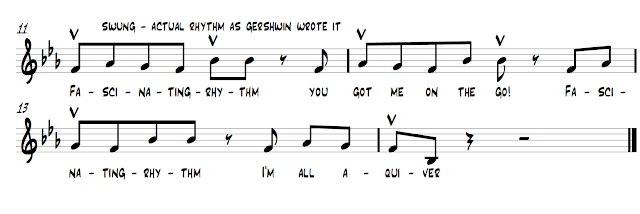Fascinating Rhythm
And we're back with Fascinating Rhythm by George Gershwin!
We're offering you a few versions of this gem:
The original, performed by Fred & Adele Astaire with Gershwin on piano:
Tommy Dorsey Orchestra:
Jacob Collier's version:
What is so fascinating?
So, the first thing we need to understand is that the rhythm in this piece is "swung", meaning that "straight" quavers sound more like the top line (x), tripletised, so that the second note of each pair of swung quavers tucks in a quaver triplet before the next beat:

See this for more on swung rhythms.
"Swinging" rhythms is a standard way of performing jazz music. However, what's more "fascinating" about this chorus melody is how it subverts our expectations, especially by playing with unexpected rhythmic emphases.
Conventionally, such a melody might be written like this: two, 2-bar (sub)phrases in 4/4 time with relatively conventional word emphases.
Even in this "conventional" version, we already have a rhythmic a displacement of the first six quavers: in bar 1, the F is on the downbeat, but by bar 2, the F has already happened before the downbeat making the A flat (second note of the motif) occur on the downbeat. We might also expect some rhythmic impulse on beat 3 of bar 4, but the melody is cut off before then and the listener is left hanging.
This displacement now also means that the first two B flats ("Rhythm") are a tripletised quaver away from each other, whereas the B flats of bar 2 ("the go!") are right up next to each other, rhythmically speaking:
However, what we hear from Gershwin, is that the third sub-phrase (or set of 6 notes) comes a beat sooner that we expect, wading in on beat 8, creating a 4/4 + 3/4 = 7/4 feel.
In actual fact, we come to realise that what Gershwin has done, is move that 6-note phrase (although its fourth iteration is only 5 notes) behind the bar-line by one quaver more each time it is heard. This means that by the end of the fourth iteration, each note of the six-note motif, receives an on-beat emphasis.
Here is the 6-note motif:
F - A flat - G - F - B flat - B flat
1st iteration: F - A flat - G - F - B flat - B flat
2nd iteration: F - A flat - G - F - B flat - B flat
3rd iteration: F - A flat - G - F - B flat - B flat
4th iteration: F - A flat - G - F - B flat - B flat
There you have it. Fascinating...
 |
| The Gershwin brothers: Ira and George |





Comments
Post a Comment